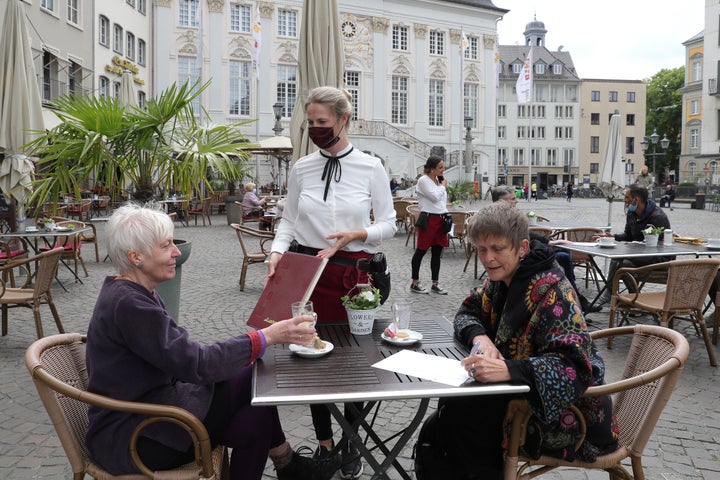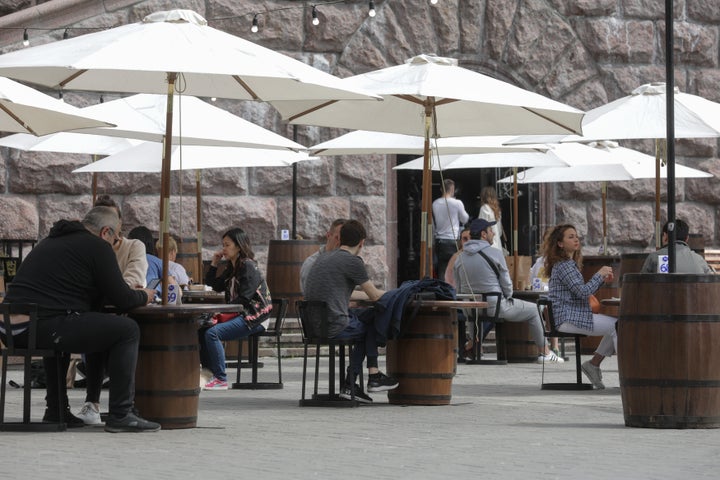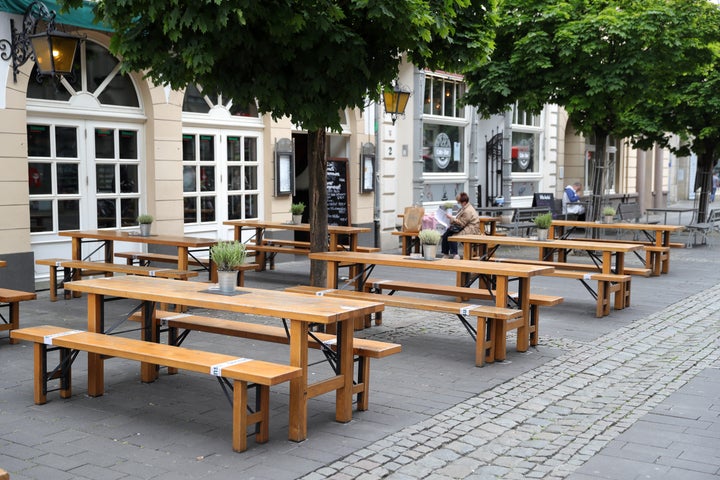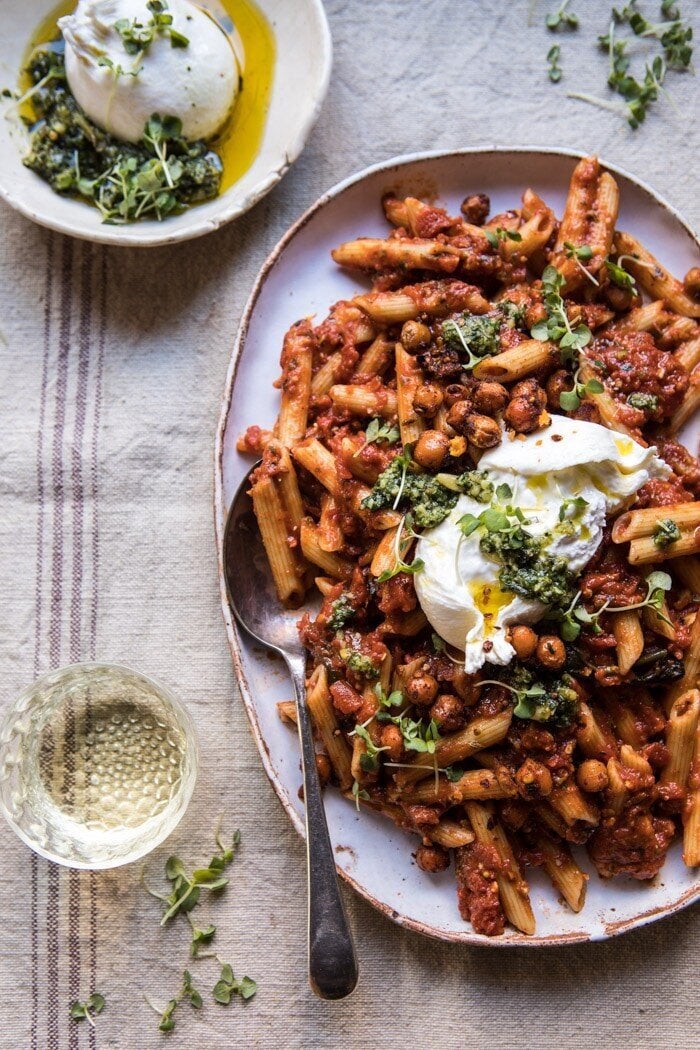As stay-at-home orders elapse in the wake of the coronavirus pandemic, restaurateurs will need to formulate plans for when, how and whether to fully reopen to the public. But what will the restaurant world look like then, and how will businesses adjust to an entirely new set of expectations and norms?
Restaurant reopenings will undoubtedly be trying endeavors, given the state of public health and the natural apprehension many Americans are feeling right now. But the food and beverage industry has a track record of resilience and determination, and that’s why plenty of chefs and restaurateurs feel confident in their ability to weather this storm.
“I think challenging and unknown times still lie ahead, but I do know and have faith in the passion and creativity of the restaurant industry and the appreciation [people] have for food and for keeping our food culture unique,” executive chef Heena Patel of Besharam in San Francisco told HuffPost. “As an industry, we will all adjust and do everything we can to keep/bring back our staff and do what we love the most, feeding our community.”

So what will this new frontier of restaurant culture look like? We spoke with a group of restaurant owners, chefs and managers to get their thoughts on this matter.
Even after shutdown orders elapse, many restaurants will take their time to reopen their dining rooms.
In states like Georgia and Texas, restaurants have the legal ability to reopen their dining rooms to those who’d like to dine onsite. But even if state law doesn’t prohibit this move, many restaurateurs in major foodie areas like Atlanta and Austin are choosing to delay their reopenings until post-quarantine conditions seem more stable.
“Right now, the landscape in Atlanta is mixed, with some restaurants that have resumed operations and some that have yet to do so,” explained Mandy Slater, co-owner of 9 Mile Station. “Some restaurateurs are hesitant, but for varying reasons ― some have small, intimate dining rooms and can’t make it work with our current restrictions. Some have a thriving takeout business currently and don’t need or want to undertake an entirely new operational plan right now, so they are taking their time to open up in the way that makes the most sense for their business. And others just don’t feel that they can open safely right now.”
For co-owner Adam Orman of L’Oca d’Oro in Austin, reopening his dining room right now doesn’t add up financially, and he feels that using that space for other endeavors is a better way to channel his resources.
“If we put our tables six feet apart, we will have about 40 seats, including outdoor seating, which is only about one-third capacity,” Orman told HuffPost. “We’re not about to try and put them closer together, and we hope that our colleagues won’t either because we can’t afford, financially or emotionally, to shut down again.”
He also explained that if his restaurant rearranges the dining room to accommodate sit-down diners, it would have to sacrifice its to-go business and food bank contributions, which are all put together in the dining room space.
Social distancing is here to stay.
Restaurants generally agree that their dine-in businesses can’t safely restart unless their staff and clientele maintain social distancing measures and standards.
“We know we will need to minimize our table count in order to spread them further apart and maintain as much social distancing as possible,” said general manager Gina Buck of Concord Hill in the New York City borough of Brooklyn.

New York City-based restaurateur David Burke agrees that spacing needs to be a massive priority when his restaurants reopen, and he plans to apply social distancing rules to staff and vendors as well as guests.
“We’ll be limiting staff and hours and looking at traffic patterns,” Burke told HuffPost. “At our townhouse where David Burke Tavern is located, the landlord has been very kind in allowing us to use her door so we can create one-way traffic for our guests, like the grocery stores’ one-way aisles.”
In addition, Burke said the stools at the bar will be removed and no vendors will be allowed inside. Instead, restaurant employees will accept product deliveries on the sidewalk, unpacking them there and disposing of the packaging outside.
Outdoor seating is a major boon to restaurants eager to resume “normal” operations.
Outdoor dining spaces seem like a natural solution to distancing concerns since they typically offer customers more opportunities to spread out and avoid close contact.
“Our business is unique in that it’s very large and nearly all outdoors,” Slater said of her Atlanta space. “Social distance of six feet is easily achieved and crowd and occupancy control is something we do on a daily basis.”
Chef/owner Max Hardy of Coop Detroit also sees the value in outdoor seating, especially if the restaurant occupancy limits are similar to the ones already being enforced in reopened states. “The 25% capacity limit won’t work in Detroit, in my opinion,” he told HuffPost. “Most restaurants operate on small margins already. Some owners and restaurateurs take home about 25% profit only, after expenses and taking care of their staff. Outdoor seating will help ease concerns and give guests peace of mind; it will also allow restaurants more curb appeal to attract additional guests.”
Curbside pickup and delivery will likely become a regular occurrence, even at high-end restaurants.
For many upscale restaurants, the pandemic-related shutdowns prompted their first-ever forays into delivery and takeout. Co-owner Rick Wahlstedt of Le Bilboquet and Le Colonial in Atlanta believes that these to-go operations will persist long after restaurants resume full service because “the home has become a sanctuary of safety and will remain that way.”
“With this in mind, I believe that curbside pickup and take-out from high-end restaurants will continue and even develop post pandemic and the years to come,” he said.
Washington, D.C., chef and restaurateur Spike Mendelsohn also sees a bright future for high-end food delivery, but he hopes that third-party delivery vendors will reduce their commission rates and allow for more manageable relationships with restaurants: “Pre-COVID, many restaurants looked at working with third-party delivery services (UberEats, GrubHub, Doordash, Postmates) as a supplemental revenue stream,” Mendelsohn told HuffPost, “and we were willing to take a hit with the huge marketplace commissions they charged us (30% and higher) as a way to introduce at-home customers to our product.”
“I believe increased delivery will persist long past the pandemic, and it will become a primary revenue stream for many restaurants,” he continued. “I am hopeful that these third party facilitators will drop their commissions to more reasonable rates long-term.”
Restaurant staffers will undergo regular health screenings and wear protective gear for the foreseeable future.
Social distancing and the willingness of guests to wear masks will contribute to a safer post-pandemic dining experience, as will screening policies and protective equipment for restaurant employees.

“In preparation for our reopening, we put new measures in place and held a meeting with all of our employees to address any concerns and discuss new policies,” said Daniel DeLeon, owner of Grumpy’s Restaurant in Jacksonville, Florida.
“We made the decision to implement temperature checks on all staff members every morning before they clock in, as well as a health screening to make sure they are feeling well before interacting with any customers or fellow employees,” DeLeon explained. “As always, everyone wears gloves and all kitchen staffers are now required to wear masks. We have also put in five new hand sanitizing stations for both guests and employees throughout the restaurant, positioned by entrances and high-contact areas.”
Owner Kristen Heaney of Yard Bar in Austin reopened her establishment on May 1 by taking clear precautionary steps to ensure the safety of her staff and her customers.
“Tables that were once communal now only seat parties up to six and are now spaced 10 to 12 feet apart to ensure ample room for safe distancing,” Heaney said. “Our guests are asked to wear masks as they come and go from their tables. We have patio staff to answer questions about our menu and share details about our new operations, and all ordering and payment is done online. Our staff — wearing masks and gloves — deliver food and drinks by tray to a cart that is set six feet away from the guests’ table. The staff discusses what’s on the tray, answers any questions, and then leaves the guests to pick up their items from the tray. Our staff are all temp checked before their shifts and interviewed to confirm they are neither experiencing any COVID-19 symptoms nor have they made any known contact with a coronavirus carrier.”
“We can’t afford, financially or emotionally, to shut down again.”
- Adam Orman of L’Oca d’Oro in Austin, Texas
Chef Nicola Blaque of The Jerk Shack in San Antonio, Texas, has justifiable concerns about larger groups attempting to gather in her restaurant, and while she’s still holding off on reopening her restaurant, citing a wish to see a more substantial decrease in the virus’ spread before taking that chance, she hopes that guests will exercise caution and a healthy dose of common sense before meeting their friends for a bite.
“Guests should expect to eat in smaller groups. You don’t have to eat with 10 friends,” she said. “I understand why people would want to eat out with all their friends, but we value our guests’ safety.”
Especially in large cities, the government needs to step up and help restaurants regain their footing.
As the nation’s largest coronavirus hot spot and also one of its most expensive cities, New York City faces unique challenges when it comes to restarting its legendary dining and drinking scene.
For that reason, chef/owner Ron Silver of Bubby’s in Manhattan urges the city and state governments to work with the restaurant industry to support viable reopening plans.
“I hope and trust that the city will give their full support to the restaurant industry. I want the mayor, governor, and city council to really work with us and provide us with the necessary financial safeguards and consideration that will allow us to rebuild and reestablish ourselves.”
Most of all, Silver hopes the city handles post-COVID better than it has handled past disasters. Working with Bubby’s since 1990, Silver saw Bubby’s become a distribution hub for first responders after the terrorist attacks of Sept. 11, 2001.
“But what came after that was a disgrace,” he said. “The city tripled our sidewalk café fees and sent in Consumer Affairs, the Sanitation Department and the Health Department to extract erroneous nickels and dimes from us. There was something else at every turn. We do not want to see that again. Our industry was arguably one of the hardest-hit, and we hope the city does not attempt to recoup lost revenue by coming after us struggling restaurants.”
